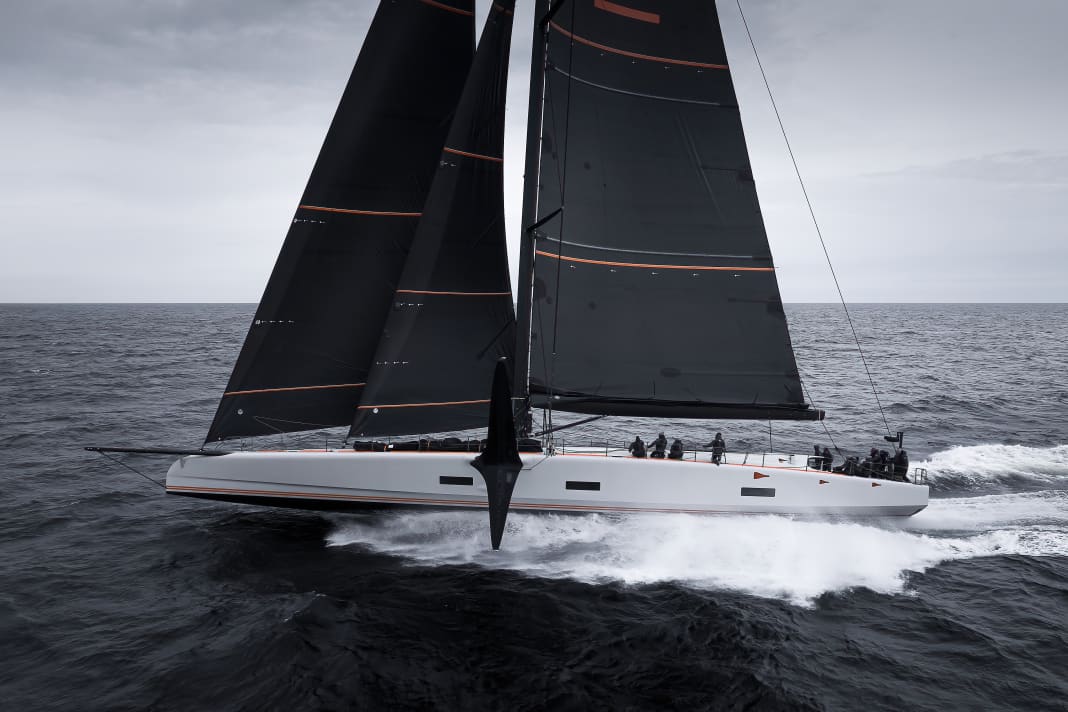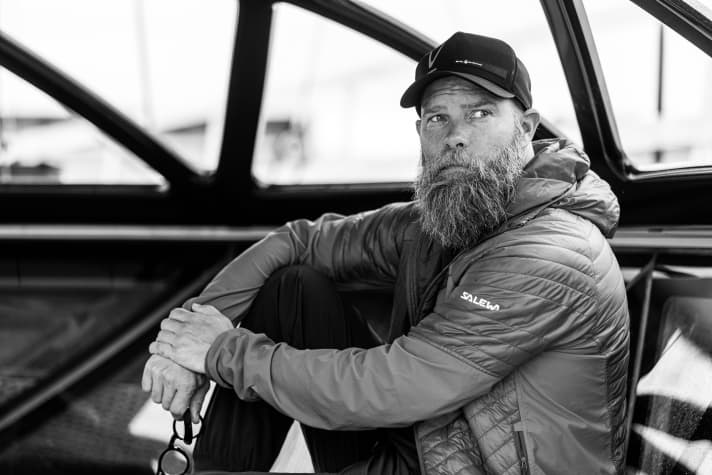





Raven" never flew, the hull always maintained contact with the water. The Baltic 111 is designed to sail on the leading edge, while the leeward T-foil carries around 60 per cent of the displacement - and the 34-metre-long monohull shoots across the sea like a catamaran. Vertically extendable flaps on the transom and flaps in the trailing edges of the wings take care of the trim. The profiled carbon fibre foil achieves the same effect under water as it does in the air: it generates lift. So much for the theory, the practice now followed on the northern Baltic Sea. And it turned out just as the renderings had visualised. The sky was cloudy and as grey as the water, the wind and waves were moderate. Only the ravens in the accompanying flight were missing.
"Raven" consistently fast right from the start
Partly under full mainsail, staysail, genoa and the code zero on the eight-metre bowsprit, "Raven" consistently logged over 20 knots. The top speed during the ten-day test sail with skipper Damien Durchon was 29 knots. Concept developer Jarkko Jämsén was also on board. The Finn does not rule out the possibility of the rudder blades of "Raven" being fitted with foils, known as elevators, at some point. "Dry sailing" above the water surface is possible in principle - the 9.3-tonne keel bomb would certainly have to be slimmed down a little for this - but the limiting factor would then be the rig and the forces acting on the carbon ensemble during lift-off. It is certain that the test runs will continue in more southerly climes after delivery.
Speed-hungry owner, disruptive designer
The "Raven" owner commissioned Jarkko Jämsén about five years ago to design a super-maxi for day trips and the odd long haul. The main requirement was that the new boat should be faster than previous monohulls of around 100 feet, including "Comanche" (now "Andoo Comanche"). The Finn studied shipbuilding and industrial design and is co-founder of the Aivan design agency and the Navia design office. Jämsén learnt to sail on lakes with his own designs and constructions and is a great fan of the US designer Nat Herreshoff, who developed the ten-metre catamaran Tarantella almost 150 years ago. Gordon Baker's foil dinghy designed for the US Navy also provided inspiration. Its wooden wings had to be cranked into position by hand, but they were already capable of 30 knots in the 1950s. Finally, Jämsén envisaged the T-foils for the fast supersailor, as introduced by the AC75 in the 2021 America's Cup.
Baltic Yachts from Finland accepted the challenge, the Spaniards from Botin Partners calculated the complex carbon construction and A2B Marine Projects supervised the construction, which began with a 1:1 scale tilting plywood mock-up. Rumours spread on the scene and the first launch in early July 2023 clarified the bold dimensions of the project. The team initially opted for test launches without hydrofoils, but with filled ballast tanks. This ensured that all hydraulic, electrical and electronic systems, including the diesel-electric drive, functioned smoothly. At the beginning of September, Baltic added T-foils to the flanks of the 4.80 metre deep fixed keel at the shipyard in Jakobstad.

Every gram counted during construction
For "Raven", Baltic Yachts realised the most intensive weight savings in the shipyard's fifty-year history. At 55 tonnes, the radical construction displaces a whopping 40 tonnes less than "Zemi", the Baltic 110 recently launched as a fast blue water cruiser, and yet the Baltic 111 was given a reasonably cosy interior that virtually merges with the carbon fibre outer shell. All the furniture is based on carbon fibre tubes, with lightweight materials such as rattan used as upholstery. At the front of the main saloon there are toilet and shower cubicles with visual contact to the large hydraulic cylinders of the foils.
The bird's nest cockpit has been arranged separately from the aft work area in favour of guest safety. It is protected by a folding hard bimini that pays homage to the hardtop of the 2005 Ferrari Super America. Steering is from a semi-covered Imoca-style work area, with twin wheels and all winches for sail control within easy reach of the crew. The characteristically narrow bow allows the best foresight in foil mode, and the shape also provides aerodynamic and hydrodynamic advantages.
Jämsén describes the design concept as "holistic", as the exterior and interior form a single unit. The structure of the boat can be experienced in the interior and becomes part of the design. "What is not normally visible can now be seen," says the Finn. "There's an aggressive, brutal side to the design, like the carbon fibre structure itself, the systems, the wiring and the piping, with a thin layer of luxury in between."

